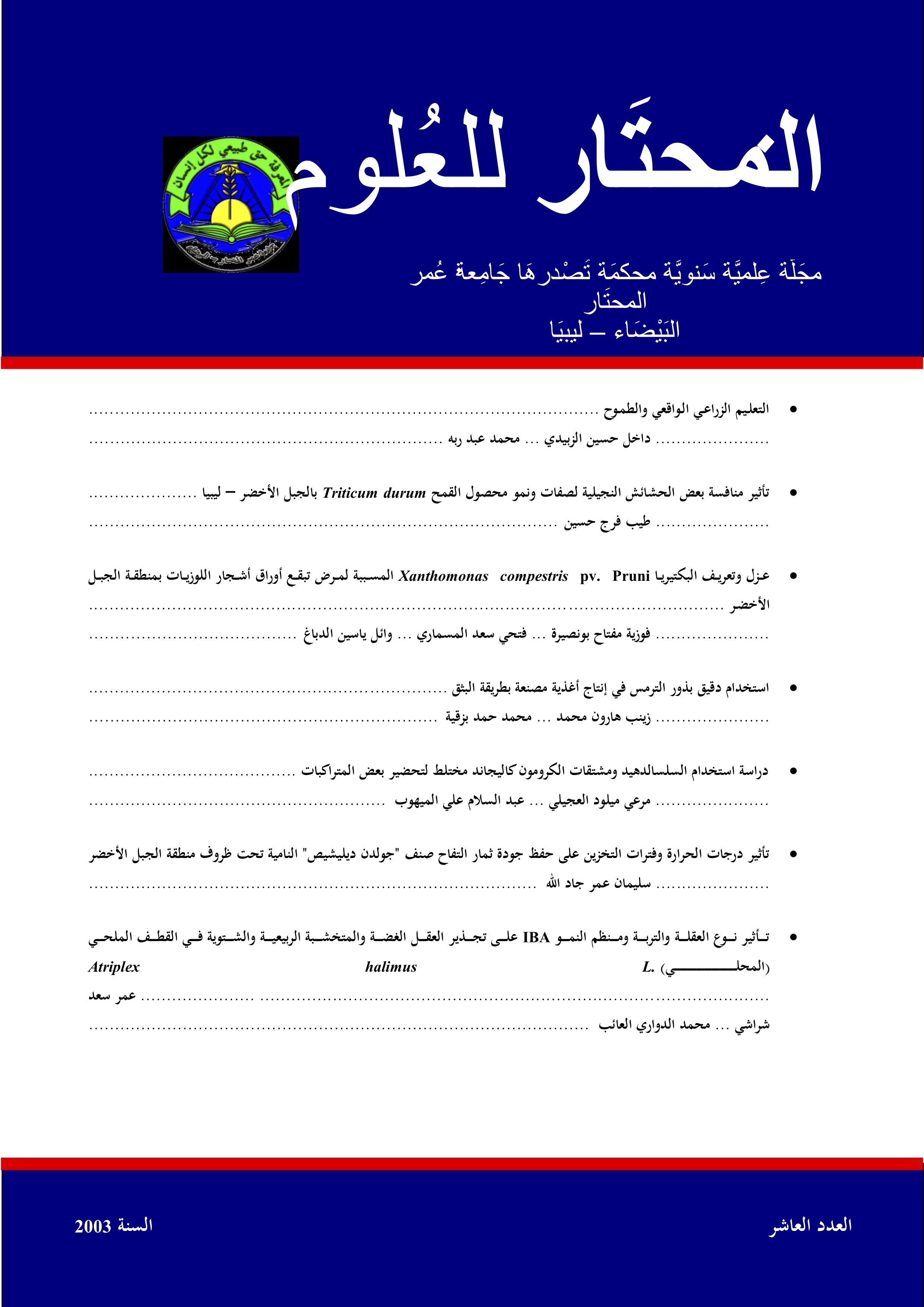Competition Ability of Some Weeds to Crop Growth And Yield in Gabal Akhdar Area
DOI:
https://doi.org/10.54172/mjsc.v10i1.501Keywords:
Competition Ability , Gabal Akhdar , LibyaAbstract
Wheat is an importante source of protein, fibers, minerals and nutrietional biological human energies. The crop yield increase to 9.5 Mt/year, however this yield shearing with 20–35% of world supply. The research centers amied to increase unit area yield by reducing the yield limiting factors, the weeds is an importante factors that limited yield. The grass weeds is an important weeds due to Homogeris to wheat growth & yield factors. The objective of this study was conducted to quantifying the yield losses due to grass weeds competition these weeds were include wild oats Avena fatua L., rye grass Lolium multiflorum L. and cat tail Phalaris minor L. with seed deusity 45 seeds/m2 disterbuted due to receptical design of competitive ability research. The crop sowed by 190 grain/m2. This study was designed by Randomized complete block with 4 replicates each having 4 treutments were [control (Free of weeds), (Wheat + Ryegrass), (Wheat + wild oats) and (Wheat + cattail)]. The results of this study revealed significant reduction in crop growth and yield characters. The crop yield was 1.2 t/ha from rye grass competitive study. The yield of control was 3 t/ha there was a phenomena that the cat tail was increase the yield of this crop to 4.5 t/ha. Therefore more study was needed to clearfying this phenomena.
Downloads
References
Agcaoili, M. C. and Rosegrant, M. W. (1994). World supply and de¬mand projections for cereal, 2020. International food policy research institute. Washington USA.
Dukes, J.; Toma, R. B. and Writz, R. (1995). Cross–cultural and neu¬tritional values of bread. Cereal food world 40, 384–385.
Cochran, W. G. and G. M. Cox, (1967). Experimental design, 2nd ed wiley, New York, 6 Chaps.
Faridi, H. and Faubion, J. M. (1995). Wheat enduses around the world. American association of cereal chemists. St. paul. Minnesota. USA.
Honek, A. (1991). Nitrogen fertiliza¬tion and abundance of the cereal aphids Metopolophium dirhodum and Sitobium avenae (Homoptera Aphididae) Zeitschrift fur pfan¬zenkrankheiten und pflanzen¬schutz 98, 655–660.
Hurle, K. (1993). Integrated manage¬ment of grass weeds in arable crops. In brighton crop protection conference, weeds 1993. British crop protection council, thornton heath. U. K. pp. 81–88.
Kropff, M. J. and Lotz, L. A. P. (1993). Empirical models of crop–weed competition, 9–24. In “Modelling crop–weed interac¬tion” by M. J., Kvopff and H. H., Van Laar (eds). CAB Interna¬tional in association with the in-ternational Rice research insti¬tute, 1099 manila, the Philip¬pines.
Mead, R. (1979). Competitive ex¬periments biometrics 35: 41–54.
Roger, G. P. (1994). Agricultural field experiment design and analysis. Marcel Dekkes, inc. Oregon state USA.
Spitter, C. J. (1990). On the descriptive and mechanistic models for interplant competition, with particular reference to crop-weed interaction. In: Rabbinge, R; Goudriaan, J; van keulen, H; Penning de varies, F, W. T. and van Loar, H, H, (eds). Theoretical production Ecology: Reflections and prospects. Simulation Monograph 34, pudoc, Wageningen, pp. 217–236.
Willey, R. W. (1976b). Intercropping, its importance and research needs: part I: competition and yield advantage. Field crop abst. 32: 1–10.
Willey, R. W. and M. R., Rao (1980). A competitive ratio for quanti¬fying competition between inter crops. Exp. Agric, 16: 117–125.
Downloads
Published
How to Cite
License
Copyright (c) 2021 Taib Farag Hesean

This work is licensed under a Creative Commons Attribution-NonCommercial 4.0 International License.
Copyright of the articles Published by Almukhtar Journal of Science (MJSc) is retained by the author(s), who grant MJSc a license to publish the article. Authors also grant any third party the right to use the article freely as long as its integrity is maintained and its original authors and cite MJSc as original publisher. Also they accept the article remains published by MJSc website (except in occasion of a retraction of the article).










